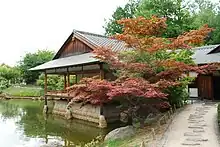.jpg.webp) | |
| Total population | |
|---|---|
| 4,931 (2017) | |
| Regions with significant populations | |
| Languages | |
| Religion | |
| Related ethnic groups | |
| Overseas Japanese |
Japanese people in Belgium or Japanese Belgians (Japanese: 日系ベルギー人) are Belgian citizens of Japanese ancestry.
History
The Japanese started to arrive in considerable numbers in Brussels in the 1950s. At this time the Belgian-Japanese economic partnerships had started. By 1992, the Brussels Japanese community was already one of the largest in Europe.[1]
In Hasselt there is a Japanese garden, donated to the Flemish city by the city of Itami, Japan.[2][3] It is the largest Japanese garden in Western Europe, extending for 2.5 hectares.[4] There are other Japanese gardens in Belgium, such as the one in the city of Ostend.[5][6] There is a good relationship between the city of Ostend and the Japanese company Daikin, located in the industrial area of Ostend, and whose company buildings can be seen along the Ostend-Brussels highway.[7] In Laeken, Brussels, there is a Japanese tower, built between 1900 and 1904 by order of King Leopold II.[8][9] Also in Brussels there is a Japanese international school, the Japanese School of Brussels, founded in 1979[10] over a Japanese Saturday school opened in 1974.[11] In Auderghem, near the Japanese School, there is a street named Avenue Nippone ("Nipponic Avenue"—Nippon means "Japan" in Japanese),[12] opened and named thus in 1986, due to its proximity to the school.[12] There are Japanese magazines published for Japanese Belgians.[13]
Demographics
As of 2021 there were about 6,000 Japanese living in Belgium.[14] In 2016 there were 2,754 Japanese in Brussels alone.[1] In 2016, most (71%) of the Brussels Japanese lived in the southeast of the Brussels Region, more precisely in Woluwe-Saint-Lambert, Woluwe-Saint-Pierre, Auderghem and Watermael-Boitsfort.[1] 62% of the Japanese community in Belgium lives in Brussels.[1]
The Japanese community of Belgium was by 1992 one of the largest in Europe.[1] The number of Japanese in Belgium is currently stagnating compared to the rising numbers of other Asian nationalities such as the Chinese and Indians.[1]
Notable people
- Yumi Lambert (1995), model[15]
See also
References
- 1 2 3 4 5 6 Casier, Charlotte (November 2017). "Chinezen, Indiërs en Japanners in het Brussels Hoofdstedelijk Gewest" (PDF). FOCUS. Brussels instituut voor Statistiek en analyse. 21: 1–9.
- ↑ "A Japanese garden in Belgium". www.cruisetotravel.com.
- ↑ "Japanese Garden of Hasselt". www.smarksthespots.com.
- ↑ "The Japanese Garden, the perfect spot for a peaceful and cultured meeting". www.visithasselt.be.
- ↑ "Japanese Garden Shin Kai Tei - Nature". www.oostende.org.
- ↑ "Japanese Garden". www.visitoostende.be.
- ↑ "Takashi Sawano 's Shin Kai Tei". www.royalpalaces.be (in Dutch).
- ↑ "The Japanese Tower at the Royal Domain in Laeken: A remarkable application of Japanese lacquer techniques in Belgium". www.iiconservation.org. Retrieved 16 March 2023.
- ↑ "A ing's Dream: The Chinese Paviliion and the Japanese Tower in Laeken (Brussels)". www.theartssociety.org. 7 February 2023.
- ↑ "沿革史." (Archive) The Japanese School of Brussels. Retrieved on 9 January 2014. Table: 西暦: 1979, 元号: 4, 月, 4: "全日制日本人学校開校 文部省派遣 脇坂譲校長着任(3代)(本目英世氏は全日制教頭とする)この年より全日制校長が補習校の校長を兼務する"
- ↑ Conte-Helm, Marie. The Japanese and Europe: Economic and Cultural Encounters (Bloomsbury Academic Collections). A&C Black, 17 December 2013. ISBN 1780939809, 9781780939803. p. 104.
- 1 2 "L'avenue Nippone - 1160 Auderghem". EBRU.
- ↑ "Aoitori het medium voor de Japanse gemeenschap". www.aoitori.be.
- ↑ "Number of residents from Japan living in Belgium from 2013 to 2021". Statista.
- ↑ Satenstein, Liana (1 December 2014). "Meet 7 New Faces of the Victoria's Secret Fashion Show". Vogue. Retrieved 25 March 2023.

